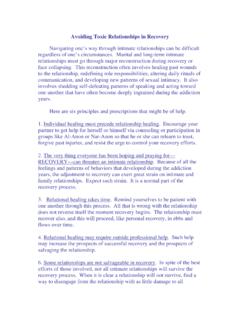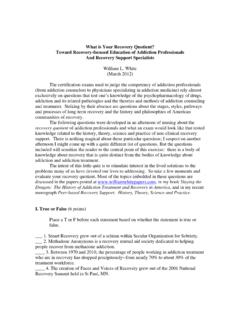Transcription of Lapse and Relapse - William L. White
1 White , W. & Ali, S. (2010). Lapse and Relapse : Is it time for a new language. Posted at Lapse and Relapse : Is it time for new language? April 2010 William L. White & Sad Ali A new addiction recovery advocacy movement in the United States is challenging many of the concepts and terms that have historically portrayed alcohol and other drug (AOD) problems (Ali, 2010; Kelly, 2004; Substance Use Disorders, 2004; White , 2006, 2007a). Recovery advocates contend that language has been an important tool in the stigmatization, demedicalization, and criminalization of AOD problems and the marginalization of people affected by these problems ( White , 2007b). Recovery advocates are calling attention to new research studies that confirm these effects (Kelly, Dow, & Westerhoff, in press; Kelly & Westerhoff, 2010).
2 The authors have been part of these extended debates about language in the addiction, treatment, and recovery arenas. In this essay, we discuss two words Lapse and Relapse that we argue are rooted in moral and religious conceptions of AOD problems and should be replaced with terms that are morally neutral and precise and that more aptly depict the processes involved in the experiences of people with AOD problems who resume AOD use following voluntary periods of sobriety. Origin and Moral Meanings The addictions field has long used the term Relapse to describe a return to drinking or drug use following a period of voluntary abstinence by those who have a history of AOD-related problems. The field has more recently attempted to distinguish Lapse or slip (a brief episode of AOD use) from Relapse (the resumption of more extended and excessive AOD use involving the return of symptoms meeting diagnostic criteria for a substance use disorder).
3 Rates of Lapse and Relapse are difficult to compare across studies due to different definitions of these terms (Maisto, Pollack, Cornelius, Lynch, & Martin, 2003; McKay, Franklin, Patapis, & Lynch, 2006; Simonelli, 2005). The Lapse / Relapse terms are rooted in morality and religion, not health and medicine, and come with considerable historical baggage. The early and contemporary meanings of these terms include: abandonment of religious faith, , lapsed Catholic, moral failing, , Lapse in grace, wrongdoing, violation of a moral standard, neglect of one s personal or social responsibilities, , Lapse in insurance coverage or membership due to failure to make payment, return of slovenly character, , Lapse into bad habits, deviation from accepted standards as a result of carelessness, negligence or lack of effort, , Lapse in judgment, deterioration in discipline or ability, , Lapse in memory, and fall, fail, regress, backslide, descend, revert.
4 These terms entered medicine at a time health conditions were thought to be inextricably linked to a person s religious or moral conduct. The onset and recurrence of many complex health problems were once shrouded in shame because of such associations. The implied moral connections between the Relapse of tuberculosis, cancer, epilepsy and schizophrenia slowly faded as the etiology and course of these disorders became more clearly understood. In the alcohol and drug problems arena, the Lapse / Relapse language emerged during the temperance movement to refer to individuals who had returned to drinking after publicly signing a temperance pledge. Falling off the water wagon was linked in the public mind to lying, deceit, and low moral character and was viewed as a product of badness rather than sickness ( White , 1998).
5 The moral overtones created by the Lapse / Relapse language shaped broader communications in which those who were drug free were referred to as clean while people who were using drugs were viewed as dirty. The moral roots of Lapse / Relapse are further illustrated in the synonyms for clean ( , pure, unblemished, faultless, flawless, good, innocent, sinless) and for dirty ( , stained, tainted, polluted, infected, defiled, foul, filthy, immoral, lewd, vile, vulgar). The Scope of Application of Lapse / Relapse Internet search technologies provide a way to investigate the frequency at which two terms are associated. Table 1 reveals the frequency with which references to Lapse and Relapse appear in conjunction with various terms used to convey the presence of alcohol- or other drug-related problems.
6 It can be seen that this pairing is most frequent in reference to the terms alcoholism and addiction. It is noteworthy that references to Lapse and Relapse terms associated with moral choice rise when paired with the term abuse another term that conveys a person of contemptible character. (Note in Table 1 how references to Lapse and Relapse increase in the shift from alcohol dependence to alcohol abuse.) The Lapse / Relapse terms combined with references to abuse convey a greater sense of personal culpability, and as recent research reveals in the case of the abuse language, elicits more punitive attitudes (Kelly et al., in press; Kelly & Westerhoff, 2010). To compare the pervasiveness of the link between Lapse / Relapse and AOD problems, we compared these references to those for the link between these same search terms and the word recovery.
7 It can be seen from Table 1 that the terms Lapse and Relapse are as pervasively linked to AOD problems as is the term recovery. Table 1: Number of Internet Lapse / Relapse References Linked to Terms used to Depict Alcohol and other Drug Problems (Google Advanced Search on February 8, 2010) AOD-related Disorder Number of Internet Lapse References Number of Internet Relapse References Total Lapse / Relapse References Number of Internet Recovery References Alcoholism 11,200,000 8,490,000 19,690,000 2,610,000 Alcohol Addiction 8,930 121,000 129,930 465,000 Alcohol Dependence 43,600 142,000 185,600 159,000 Alcohol Abuse 97,800 622,000 719,800 890,000 Addiction 520,000 1,490,000 2,010,000 2,290,000 Drug Addiction 161,000 484,000 645,000 1,390,000 Drug Dependence 11,000 131,000 142,000 282,000 Drug Abuse 762,000 130,000 892,000 2,000.
8 000 To compare the application of the Lapse / Relapse terms to alcohol and other drug problems and other chronic medical disorders, a similar search was done on the pairing of references to Lapse / Relapse with other chronic disorders. Table 2 reveals the wide application of the terms Lapse / Relapse to other medical and behavioral health conditions. This would seem to indicate the medical legitimacy of these terms, but three points challenge such a conclusion. First, many of the conditions listed contained moral overtones during earlier historical periods, and continued use of the Lapse / Relapse language may reflect such residual effects. Second, the term Relapse is being abandoned in fields such as cancer treatment for more medically precise and morally neutral terms, , recurrence.
9 Third, Lapse and Relapse are not applied to these conditions nearly as frequently as they are to AOD problems. The terms Lapse and Relapse are applied to alcoholism more than to any other single medical condition listed in Table 2. Table 2: Number of Internet Lapse / Relapse References Linked to other Chronic Disorders (Google Advanced Search on February 8, 2010) Chronic Health Disorder Number of Internet Lapse References Number of Internet Relapse References Total Lapse / Relapse References Diabetes 506,000 8,060,000 8,566,000 Type I Diabetes 31,600 147,000 178,600 Type 2 Diabetes 45,000 182,000 227,000 Cancer 1,500,000 3,020,000 4,520,000 Tuberculosis 1,300,000 3,910,000 5,210,000 Hypertension 1,600,000 4,910,000 6,510,000 Epilepsy 1,740,000 3,220.
10 000 4,960,000 Asthma 2,850,000 4,990,000 7,840,000 Depression 1,220,000 2,010,000 3,230,000 Schizophrenia 118,000 5,330,000 5,448,000 Mental Illness 216,000 702,000 918,000 AIDS 887,000 955,000 1,842,000 The applications of the terms Lapse and Relapse are by no means restricted to medical conditions. Table 3 illustrates the widespread application of these terms to a spectrum of immoral and criminal behaviors. Table 3.












